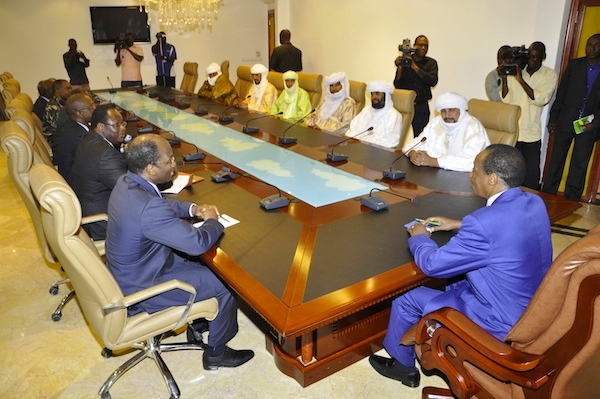For centuries, the people of Timbuktu have sought guidance from their Sufi saints. They took pride in the mausoleums of these medieval Muslim holy men, who spread their faith around the world from a city built on the profits of gold, salt and slaves.
When I visited six years ago, a teenager showed me around, pointing out the shrines. As we stood by a monument to peace built in 1995 to mark the end of the last Tuareg uprising, with guns embedded in its concrete, I handed him a few coins. He gave them to children standing nearby. ‘My religion says we should share,’ he said.
Today, the mood is different. Islamic extremists, who hold the shrines and tombs to be idolatrous, are tearing them apart with pickaxes, iron bars and shovels. There are fears for the great libraries, which hold hundreds of thousands of precious manuscripts. The monument to peace only serves to mock the murder and mayhem engulfing Mali.
The demolition of the tombs is a tragedy. But the bigger tragedy is that it took the destruction of buildings — rather than lives — to bring the world’s attention to what’s happening in Mali. A decent democracy has disintegrated, families have fled their homes and allies of al-Qa’eda have seized control of an area of Africa the size of France. Al-Qa’eda has never come closer to power.
How did this happen in a tranquil nation famed for mangoes, music and mud houses? Like many African countries, Mali has borders bequeathed by colonialism, containing diverse and often disharmonious groups. It is also suffering collateral damage from the uprising in Libya. Gaddafi pumped money into Mali, and kept Islamists at bay, but also backed Tuareg separatists in the north. As his regime crumbled last year, veteran Tuareg leaders returned home with heavily armed, battle-hardened troops. A nationalist revolt flared up again in the northern deserts.
What happened next was farcical. In March, angry at being sent into battle without bullets or proper boots, government troops at a dilapidated barracks near the presidential palace mutinied. Within hours they found that they had accomplished a full-scale coup under the command of a rather dim-witted leader, Captain Amadou Haya Sanogo. The junta said it was after more resources to take on the Tuareg rebels. Instead, it lost control of the north, which declared independence.
For the south of Mali this has been a disaster. Aid has dried up. Foreign investors and tourists have fled. Elections have been cancelled. There has been widespread looting in the capital; state television has halved the length of the evening news because so many of its cameras have disappeared. And yet such was the unemployment and corruption under the tired government it toppled that the coup retains some support on the streets.
The bigger calamity is in those northern deserts, the Sahel. Tuaregs are comparatively relaxed in their religious beliefs. Their women go uncovered; their music is famous from Timbuktu to Toronto. The Tuareg militia that took advantage of the coup to proclaim the republic of Azawad was far from angelic, but it was secular and at least claimed to be democratic. But it was rapidly outgunned by extremist groups full of foreign fighters and reportedly funded by the likes of Algeria and Qatar. This struggle came to a head at the end of last month in the town of Gao, when the Tuareg lost a two-day battle against an al-Qa’eda offshoot. The Sahel’s three main cities are now under the control of fundamentalists.
At the centre of it all is Iyad ag Ghaly, a member of the most important Tuareg clan and leader of a previous Tuareg rebellion, who is now a born-again Islamist under the influence of Pakistani jihadists. He heads Ansar ud-Dine, the group that seized Timbuktu.
The rule of the militants is harsh: they have whipped men for watching television. But any order is welcome when gangs rampage through the desert, children are being forced to fight and there are 365,000 refugees.
For nearly a decade, al-Qa’eda has sought a ‘new Afghanistan’ in Africa. Now its untidy offshoots are creating one. The destruction of the shrines shows their contempt for others, as the Taleban’s demolition of the giant Buddhas of Bamiyan did in 2001. Foreign fundamentalists are flocking in.
No one should doubt Mali’s importance. It is in a strategically sensitive spot. It has close links to Europe, especially France. Now the choice is this: once democracy is restored in the south, as it must be, do we support the rebels trying to break up the country, bearing in mind the dangerous precedent that sets elsewhere in Africa? Or do we sit back and watch militants cause misery and mayhem? This is the devil’s own dilemma, but it is hard to see any other choices.
Ian Birrell is a contributing editor of the Daily Mail.






Comments